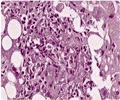
Pollen spreads in the air and is considered to be one of the main causes of allergies – and its impact on human health may increase due to climate change. For that reason, there is great interest in the research of pollen and its spread and distribution in the atmosphere. In addition, pollen is a considerable natural source of pollution in the atmosphere where it scatters sunlight - so-called corona effects have been known about for a long time.
Due to the extremely short measurement times in the near field of the laser, it is difficult to measure close to the ground where pollen is usually found. Furthermore, specific measurements are needed to separate man-made air pollution from natural sources of pollution such as pollen. The first person to use lasers from the ground to investigate pollen is Prof. Kenneth Sassen of the University of Alaska in Fairbanks, USA. He collected pollen emissions data over Alaskan forests in 2008.
The results presented in this new study are the first investigations of this kind outside of North America. By using more sophisticated laser measurement techniques, the results also measure some properties of airborne pollen. "For the first time different optical properties of pollen in the air were measured. Of specific interest is the light-extinction coefficient, as this parameter allows us to determine the so-called optical depth of the atmosphere. The optical depth determines how much sunlight from space arrives on the Earth's surface, and this measurement has a major influence on our planet's temperature", summarizes Dr. Young Min Noh from the Gwangju Institute of Science and Technology (GIST).
A polarization lidar, a tool used to observe particles in the atmosphere with a laser beam, was used by the South Korean–German research team to observe the vertical distribution of pollen in May 2009 at GIST in Gwangju (South Korea). The tool measures the difference in time between the emission of a laser pulse and receiving the back-reflected laser pulse, which allows the distance between the instrument and the reflecting object to be computed - similar to the way in which radar works. Scientists can determine physical properties of the reflecting objects by measuring the polarization changes of the back-reflected laser light. The measurements showed that pollen can be found at the highest point in the atmosphere during noontime due to air convection.
Strong changes in polarization were reported during the morning at around 9 am local time at up to 500 m above the ground; at heights from 1.5 to 2 km above the ground between noon and 2 pm local time; and near the ground after 5 pm local time. These results are described by the research team in another publication that was published in Atmospheric Chemistry and Physics which is an open access journal of the European Geosciences Union (EGU). "In this study we report on the backscatter coefficient of pollen for the first time.
Advertisement
Source-Eurekalert











